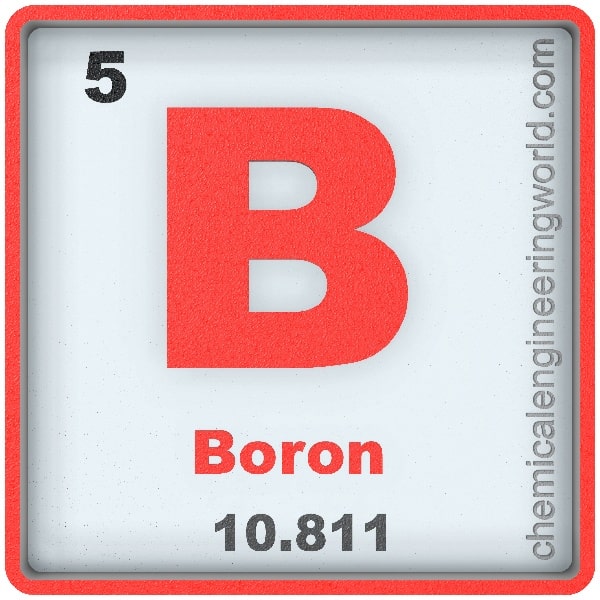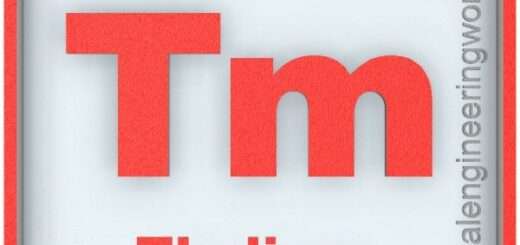Boron Element Properties and Information

Boron Element Properties and Information
Boron is fifth element on the periodic table. Elements are arranged in the periodic table on the basis of the atomic number. Atomic number is the number of protons in the nucleus of the atom. Boron has an atomic number of 5. It is located in the Group 13 and Period 2 of the periodic table of elements. It is denoted by B. The name is derived the Arabic word ‘Buraq’ which refers to borax.
Boron was extracted for the first time in 1808 independently in France by Louis-Josef Gay-Lussac and Louis-Jacques Thénard and in London by Sir Humphrey Davy by heating borax with potassium metal. The element extracted was not pure. Totally pure element was obtained by E. Weintraub by sparking a gas mixture containing boron chloride and hydrogen.
Boron is a low abundance element in the universe. On earth it accounts for 0.001% weight of earth’s crust. It is not present in environment in its elemental form. It always occurs in combination within its minerals. It is found combined in borax, borates and other minerals. It occurs as orthoboric acid naturally in volcanic springs.
Physical Properties
- Pure boron is a dark amorphous powder.
- The atomic mass of boron is 10.81
- The melting point of boron is 2076°C
- The boiling point of boron is 3296°C
- The density of boron is 2300 in S.I. units at 20°C
- Boron is a poor electrical conductor at standard temperature but a good electrical conductor at high temperatures.
- Boron is the only non metal among the Group-13 elements.
- Compressing boron above pressure of 160 Gpa and temperatures between 6-12 K produces a boron phase which is a superconductor.
Chemical Properties
- Boron is unreactive to oxygen, water, acids and alkalis. When it is finely divided then it reacts slowly with hot acids.
- Many organoboron compounds are useful in organic synthesis. Many are made by hydroboration technique utilizing diborane.
- Boron trifluoride does not have a proton but yet it is able to act as a lewis acid and able to catalyse a range of reaction by coordinating with the lone pair.
Methods of Production
- Reduction: Volatile boron halides are reduced by hydrogen at high temperatures. It results in very pure production of boron element.
- Decomposition: Ultrapure boron is produced by decomposition of diborane at high temperatures. It is further purified through the process of zone melting.
Relevance in Chemical and Related Industries
- Glass and Ceramic Industries: diboron trioxide, silica and aluminium oxide are the constituents of the popular borosilicate glass. This glass gives good resistance to thermal shock. Borax is widely used in ceramic industries.
- Metallurgical Industries: Addition of boron in steel and other alloys increases surface hardness appreciably.
- Detergents: A boron compound named sodium perborate serves as an oxygen source for many detergents and bleaching agents.
Relevance in Other Industries
- Fiberglass Industries: It accounts for the largest consumption of Boron. Boron is added to the glass to increase the strength and fluxing qualities. It is added in the form of boron oxide or boron pentahydrate. Boron fibres are produced by chemical vapour deposition of boron.
- Semiconductor Industries: Boron is used as a dopant for semiconductors. The boron is introduced by a process of atomic diffusion or ion implantation. For atmoic diffusion the boron source can be either solid, liquid or gas phases but for ion implementation method, the widely used boron source is boron trifluoride gas. Boron trichloride gas is used for plasma etching of metals and their oxides.
- Magnets: Boron is an important constituent of the neodymium magnets. They are among the strongest types of permanent magnet. They are found in MRI, HDD, CD and DVD players etc. Neodymium magnets deliver intense rotary powers in compact sizes.
- Nuclear Industries: Boron has a high neutron capture cross section hence it is used as a neutron moderator in nuclear reactors.
- Medicine: Some eye antiseptics contain Boric acid. Boric acid is used as water clarifiers for swimming pool because it has antiviral, antifungal and antiseptic properties. Some organic boron compounds are used to treat fungal infections.
Health Effects on Exposure
- Over Consumption: Humans consume boron indirectly because it is present in small amounts in fruits and vegetables. If the concentration of boron increases in human body then it may cause irritation in eyes, nose and throat and even more increase infects the major organs of human body such as brain, stomach, liver and kidneys which may eventually lead to death.
Effects on Surroundings
- Toxicity: Boron is essential for growth and nourishment of plants and vegetables unless and until it remains in a certain range. If the concentration of boron increases then it may cause tip and marginal necrosis and overall growth performance. High concentrations literally act as toxins.
- Absorption: If animals absorb large concentrations of boron over a large amount of time then their reproduction organs will get affected and while animals are exposed to it during pregnancy then the offspring is born with birth defects.
References:
































